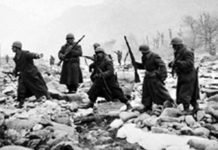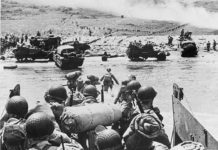Korea was for many centuries known as the Hermit Kingdom, since it prevented anyone entering or leaving the kingdom. This helps to explain the amazingly unified and homogeneous nature of Korean culture. However, to understand why this drastic policy was created and enforced for so many centuries, it is necessary to consider the many scores of attempts that have been made to conquer Korea, by Chinese and Japanese and by nomadic peoples such as the Mongols. Having been victimised so many times by foreign aggression, the Korean people responded by concluding that there was little of value that they could learn from the outside world and so attempted to keep it completely at bay.
One of the most determined and largest scale attempts to conquer the Korean peninsula was made by the Sui Dynasty Chinese state in the 6th Century CE. It ended as a total disaster that lead to the ending of the Sui dynasty itself and a significant reduction in the ambitions of subsequent Chinese emperors. What happened and why was it so disastrous?
The Sui emperor Yang Jian (known as Emperor Wen) achieved his conquest of China by 589 CE, thereby uniting the various Chinese cultural regions from the antipathy and warfare that had engulfed them. He appealed to his people according to Buddhist principles and claimed authority as a Cakravartid king – that is, a universal ruler worthy of kingship because of personal virtue and the mandate of heaven. Emperor Wen energetically set about reordering the administration of his empire and setting the military onto a more rational basis – as a result of internecine warfare, military units had been dispersed far and wide and command systems were very different. This reorganisation was the precursor to armed expansion in all directions. To the west, attacks on Turkic peoples were aimed in part at obtaining horses and horse-rearing territory, which was always an important objective for Chinese military leaders. In the south, an army destroyed the Cham state, deploying crossbows and pit traps to defeat the dreaded elephants.
In the north, Sui hegemony was resisted by Koguryo and the Korean peoples. Koguryo at this time occupied lands as far west as the Liao river, while aggressive Manchurian tribes had invaded to create the states of Silla and Paekche which shared the peninsula with Koguryo. Mountainous and inhospitable, Korea represented just as daunting a task then as it does now. Its capital was then Pyongyang, in the north of Korea, which was then conveniently located to direct military operations against invaders from the west. One of the most important problems facing the Chinese was how to mobilise the large armies they would need and supply them in a hostile environment. Chinese field armies were generally cumbersome entities provided with a wide range of conveniences and comforts that slowed down any movement or manoeuvres.
Koguryo forces had allied with a Tungusic tribe to raid Sui lands in 598 and this both enraged Emperor Wen and provided a sufficient reason to launch an invasion. Some 300,000 troops were mobilised for the invasion but the advent of heavy rains slowed them down and sickness and disaffection destroyed the offensive capability of the force. Nevertheless, the Koguryan king felt it prudent to apologise and this led to the continuance of an uneasy peace.
In the following years, Emperor Wen was able to complete the canal network linking the economic powerhouse of the southern region with the strategic northern region and, in 607, as a result of the revelation of secret negotiations between Koguryo and the eastern Turks, had a suitable reason to make war. As many as 30,000 naval labourers were brought up to Shandong to create an invasion fleet and the entire labour force of two provinces was ordered to provide supplies for the force. The Emperor himself arrived to take charge of the effort. As many as 600,000 people, according to the chronicles, were designated to draw ‘deer trucks’ – wheelbarrows used to transport goods. To crew the fleet, 30,000 native javelin and skirmishing infantry were brought up from the south – hardly the type of troops likely to prove a sustainable menace in the changeable weather of Korea.
Chinese armies tended to rely on heavy weight of numbers and, while we may not believe the chronicles are always accurate in actual numbers, we may be confident that the relative numbers, especially compared to the enemy, are reasonably accurate. In contrast to the wild and whirling style of battles involving the cavalry of the nomads on the northern and western borders, Chinese battles tended to be relatively static and involve massed use of archery and crossbows, as well as artillery, together with the push of spears. The ability of the general to bring overwhelming force to bear on a single point was the most likely method of obtaining a major victory. Clearly, being able to ensure this tactic as part of a seaborne invasion is always likely to prove extremely problematic, especially in the face of inhospitable terrain and with the need to import nearly all supplies.
One of the main reasons why, as late as the second half of the twentieth century, Korea ranked as one of the world’s ten poorest countries is the lack of natural resources and the difficulty in finding sufficient food.
The results of the campaign seem inevitable in hindsight. Some marginal successes achieved through weight of numbers were outweighed by the attrition caused by difficult ground, lack of food and several of the military debacles that have so studded Chinese history. The Koreans yielded nothing and every step taken by a Chinese soldier was a step that several support personnel had to take to support him. With widespread discontent and rebellion in the rest of the empire, fuelled by the absence of troops and workers, the eventual abandonment of the campaign was preordained and, apparently deprived of the mandate of heaven, the Sui dynasty was doomed.








